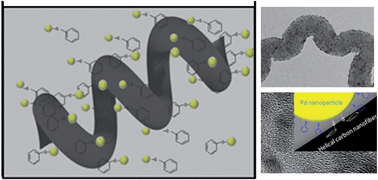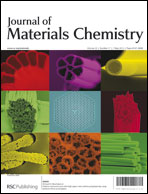Self-assembled palladium nanocrystals on helical carbon nanofibers as enhanced electrocatalysts for electro-oxidation of small molecules†
Abstract
We present a novel approach to prepare helical carbon nanofibers homogeneously functionalized with single crystal palladium nanoparticles via a phase-transfer method. The materials were characterized by scanning electron microscopy (SEM), transmission electron microscopy (TEM), X-ray diffraction (XRD), X-ray photoelectron spectroscopy (XPS), energy-dispersive X-ray spectroscopy (EDX), thermogravimetric analysis (TGA) and electrochemical measurements. We find that homogeneous and small single-crystal Pd nanoparticles can be easily functionalized with phenyl mercaptan, transferred into the toluene phase from the dimethyl sulfoxide (DMSO) phase and then non-covalently self-assembled onto the surface of helical carbon nanofibers with a very good dispersion and homogeneous diameters of 4.5 ± 0.6 nm. The palladium–helical carbon nanofiber composite exhibits significantly higher electrochemical active area and electrocatalytic activity towards the electrooxidation of formic acid, ethanol and methanol than the commercial electrocatalyst Pd/Vulcan XC-72. Our results show that the prepared material can be potentially used as an advanced nano-electrocatalyst in a direct alkaline fuel cell system.


 Please wait while we load your content...
Please wait while we load your content...